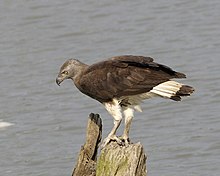Haliaeetus ichthyaetus
| Grey-headed fish eagle | |
|---|---|
 |
|
| Scientific classification | |
| Kingdom: | Animalia |
| Phylum: | Chordata |
| Class: | Aves |
| Order: | Accipitriformes |
| Family: | Accipitridae |
| Genus: | Haliaeetus |
| Species: | H. ichthyaetus |
| Binomial name | |
|
Haliaeetus ichthyaetus (Horsfield, 1821) |
|
| Synonyms | |
|
|
The grey-headed fish eagle (Haliaeetus ichthyaetus) is a fish-eating bird of prey from South East Asia. It is a large stocky raptor with adults having dark brown upper body, grey head and lighter underbelly and white legs. Juveniles are paler with darker streaking. It is often confused with the lesser fish eagle (Ichthyophaga humilis) and the Pallas's fish eagle. The lesser fish eagle is similar in plumage but smaller and the Pallas’s fish eagle shares the same habitat and feeding behaviour but is larger with longer wings and darker underparts. Is often called tank eagle in Sri Lanka due to its fondness for irrigation tanks.
The grey-headed fish eagle is included in the order Accipitriformes and the family Accipitridae, which includes most birds of prey except for the ospreys and falcons. Lerner & Mindell placed the grey-headed fish eagle in the subfamily Haliaeetinae, which includes the genera Haliaeetus (sea eagles) It was first described by Horsfield in 1841 as Falco ichthyaetus. This paraphyletic group forms a close sister relationship with the subfamily Milvinae (composed of two genera, Milvus and Haliatur), based on the shared trait of basal fusion of the second and third phalanges found only in these two groups. Some taxonomic authorities place this species in the monotypic genus Ichthyophaga.
A smallish to medium-sized but quite bulky fish eagle. Has a small bill, a small head on long neck, rounded tail and shortish legs with unfeathered tarsi and long talons. Wings aren’t very long and wingtips reach less than halfway down tail. Males and females are sexually dimorphic. The grey-headed fish eagle has a body length of 61–75 cm. Females are heavier than males at 2.3–2.7 kg compared to 1.6 kg. The tail measures between 23–28 cm and the tarsus 8.5–10 cm. The wingspan measure between 155–170 cm. Adults are grey-brown with a pale grey head and pale iris, belly and tail are white with the having a broad black subterminal band. Breast and neck are brown, with the wings on top dark brown with blacker primaries and below brown. Juveniles the head and neck are brown, greyer on the ides of throat, with buff supercilia and whitish streaks. The rest of the upperparts are darker brown, edged with grey and secondaries and tertials faintly barred. Tail black and white marbled with broader dark subterminal band and white tip. Belly and thighs white, while breast and flanks brown streaked with white. Iris is darker than adult. As juveniles mature subterminal band becomes more prominent, head becomes greyer and loses streaking becoming uniformly brown.
...
Wikipedia

